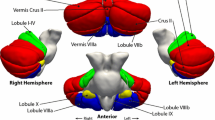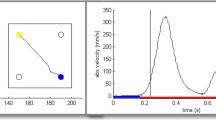Abstract
Declines in fine motor skills and cognitive function are well known features of human aging. Yet, the relationship between age-related impairments in motor and cognitive function remains unclear. Rhesus monkeys, like humans, show marked decline in cognitive and fine motor function with age and are excellent models to investigate potential interactions between age-related declines in cognitive and motor functioning. We investigated the relationships among cognition, motor function and age in 30 male and female rhesus monkeys, 5–28 years of age, tested on a battery of cognitive tasks [acquisition of the delayed non-matching-to-sample (DNMS), DNMS-120s, DNMS-600s, acquisition of delayed recognition span test (DRST), spatial-DRST and object-DRST] and a fine motor task (Lifesaver test). Global cognitive ability, as assessed by the cognitive performance index (CPI), was impaired with age in both sexes, while age-related motor slowing was found only in males. After age was controlled for, half the variance in CPI was predicted by motor speed, with better cognitive ability associated with slower motor skills. Analyses at the level of each cognitive task revealed that motor speed and age predicted the rate of acquisition of the DNMS. This relationship was robust in males and absent in females. Motor speed was not a significant predictor of any other cognitive variable. We conclude that the relationship between cognition and motor function (1) may be limited to non-spatial tasks; (2) exists independently of age; (3) may reflect different contributions of the fronto-striatal system; (4) may be particularly evident in males.



Similar content being viewed by others
References
Arnsten AF, Goldman-Rakic PS (1985) Alpha 2-adrenergic mechanisms in prefrontal cortex associated with cognitive decline in aged nonhuman primates. Science 230:1273–1276
Arnsten AF, Cai JX, Murphy BL et al (1994) Dopamine D1 receptor mechanisms in the cognitive performance of young adult and aged monkeys. Psychopharmacology 116:143–151
Bachevalier J, Mishkin M (1994) Effects of selective neonatal temporal lobe lesions on visual recognition memory in rhesus monkeys. J Neurosci 14:2128–2139
Braver TS, Barch DM, Cohen JD (2002) The role of prefrontal cortex in normal and disordered cognitive control: a cognitive neuroscience perspective. In: Stuss DT, Knight RT (eds) Principles of frontal lobe function. Oxford University Press, Oxford
Camicioli R, Howieson D, Oken B et al (1998) Motor slowing precedes cognitive impairment in the oldest old. Neurology 50:1496–1498
Casey BJ, Tottenham N, Fossella J (2002) Clinical, imaging, lesion, and genetic approaches toward a model of cognitive control. Dev Psychobiol 40:237–254
Cass WA, Grondin R, Andersen AH et al (2006) Iron accumulation in the striatum predicts aging-related decline in motor function in rhesus monkeys. Neurobiol Aging (in Press)
Chen G-H, Wang Y-J, Zhang L-Q et al (2004) Age- and sex-related disturbance in a battery of sensorimotor and cognitive tasks in Kunming mice. Physiol Behav 83:531–541
Chudasama Y, Robbins TW (2006) Functions of frontostriatal systems in cognition: comparative neuropsychopharmacological studies in rats, monkeys and humans. Biol Psychol 73:19–38
Craik FIM, Salthouse TA (eds) (2000) The handbook of aging and cognition. Lawrence Erlbaum Associates, Mahwah, NJ
Daselaar SM, Rombouts SARB, Veltman DJ et al (2003) Similar network activated by young and old adults during the acquisition of a motor sequence. Neurobiol Aging 24:1013–1019
Emborg ME, Kordower JH (2002) Nigrostriatal function in aged nonhuman primates. In: Erwin JM, Hof, PR (eds) Aging in nonhuman primates. Karger, Basel
Emborg ME, Ma SY, Mufson EJ et al (1998) Age-related declines in nigral neuronal function correlate with motor impairments in rhesus monkeys. J Comp Neurol 401:253–265
Gage FH, Dunnett SB, Bjorklund A (1989) Age-related impairments in spatial memory are independent of those in sensorimotor skills. Neurobiol Aging 10:347–352
Gallagher M, Burwell RD (1989) Relationship of age-related decline across several behavioral domains. Neurobiol Aging 10:691–708
Gallagher M, Rapp PR (1997) The use of animal models to study the effects of aging on cognition. Annu Rev Psychol 48:339–370
Gerhardt GA, Cass WA, Yi A et al (2002) Changes in somatodendritic but not terminal dopamine regulation in aged rhesus monkeys. J Neurochem 80:168–177
Grondin R, Zhang Z, Gerhardt GA et al (2000) Dopaminergic therapy improves upper limb motor performance in aged rhesus monkeys. Ann Neurol 48:250–253
Herndon JG, Lacreuse A (2002) The rhesus monkey model as a heuristic resource in cognitive aging research. In: Erwin J, Hof P (eds) Aging in nonhuman primates. Karger, Basel
Herndon JG, Moss MB, Rosene DL et al (1997) Patterns of cognitive decline in aged rhesus monkeys. Behav Brain Res 87:25–34
Herndon JG, Lacreuse A, Ladinsky E et al (1999) Age-related decline in DHEAS is not related to cognitive impairment in aged monkeys. Neuroreport 10:3507–3511
Irwin I, DeLanney LE, McNeill T et al (1994) Aging and the nigrostriatal dopamine system: a non-human primate study. Neurodegeneration 3:251–255
Jenkins IH, Brooks DJ, Nixon PD et al (1994) Motor sequence learning: a study with positron emission tomography. J Neurosci 14:3775–3790
Karni A, Meyer G, Jezzard P et al (1995) Functional MRI evidence for adult motor cortex plasticity during motor skill learning. Nature 377:155–158
Kluger A, Gianutsos J, Golomb J et al (1997) Patterns of motor impairment in normal aging, mild cognitive decline, and early Alzheimer’s disease. J Gerontol B Psychol Sci Soc Sci 52:P28–39
Kowalska DM, Bachevalier J, Mishkin M (1991) The role of the inferior prefrontal convexity in performance of delayed nonmatching-to-sample. Neuropsychologia 29:583–600
Krampe RT (2002) Aging, expertise and fine motor movement. Neurosci Biobehav Rev 26:769–776
Laakso A, Vilkman H, Bergman J et al (2002) Sex differences in striatal presynaptic dopamine synthesis capacity in healthy subjects. Biol Psychiatry 52:759–763
Lacreuse A, Diehl MM, Goh MY et al (2005) Sex differences in age-related motor slowing in the rhesus monkey: behavioral and neuroimaging data. Neurobiol Aging 26:543–551
Li KZH, Lindenberger U (2002) Relations between aging sensory/sensorimotor and cognitive functions. Neurosci Biobehav Rev 26:777–783
Li SC, Aggen SH, Nesselroade JR et al (2001) Short-term fluctuations in elderly people’s sensorimotor functioning predict text and spatial memory performance: The MacArthur successful aging studies. Gerontology 47:100
Liston C, Watts R, Tottenham N et al (2006) Frontostriatal microstructure modulates efficient recruitment of cognitive control. Cereb Cortex 16:553–560
Matochik JA, Chefer SI, Lane MA et al (2000) Age-related decline in striatal volume in monkeys as measured by magnetic resonance imaging. Neurobiol Aging 21:591–598
Miyagawa H, Hasegawa M, Fukuta T et al (1998) Dissociation of impairment between spatial memory, and motor function and emotional behavior in aged rats. Behav Brain Res 91:73–81
Moore TL, Schettler SP, Killiany RJ et al (2005) Cognitive impairment in aged rhesus monkeys associated with monoamine receptors in the prefrontal cortex. Behav Brain Res 160:208–221
Mozley LH, Gur RC, Mozley PD et al (2001) Striatal dopamine transporters and cognitive functioning in healthy men and women. Am J Psychiatry 158:1492–1499
Mumby DG, Wood ER, Duva CA et al (1996) Ischemia-induced object-recognition deficits in rats are attenuated by hippocampal ablation before or soon after ischemia. Behav Neurosci 110:266–281
Munro CA, McCaul ME, Wong DF et al (2006) Sex differences in striatal dopamine release in healthy adults. Biol Psychiatry 59:966–974
Nieoullon A, Coquerel A (2003) Dopamine: a key regulator to adapt action, emotion, motivation and cognition. Curr Opin Neurol 16(2):3–9
Park D, Schwartz N (eds) (2000) Cognitive aging: a primer. Psychology Press, Philadelphia, PA
Pohjalainen T, Rinne JO, Nagren K et al (1998) Sex differences in the striatal dopamine D2 receptor binding characteristics in vivo. Am J Psychiatry 155:768–773
Poldrack RA, Packard MG (2003) Competition among multiple memory systems: converging evidence from animal and human brain studies. Neuropsychologia 41:245–251
Rapp PR, Rosenberg RA, Gallagher M (1987) An evaluation of spatial information processing in aged rats. Behav Neurosci 101:3–12
Raz N, Williamson A, Gunning-Dixon F et al (2000) Neuroanatomical and cognitive correlates of adult age differences in acquisition of a perceptual-motor skill. Microsc Res Tech 51:85–93
Reeves SJ (2005) A positron emission tomography (PET) investigation of the role of striatal dopamine (D2) receptor availability in spatial cognition. Neuroimage 28:216–226
Reeves S, Bench C, Howard R (2002) Ageing and the nigrostriatal dopaminergic system. Int J Geriatr Psychiatry 17:359–370
Roberts JA (2002) The aged rhesus macaque in neuroscience research: importance of the nonhuman primate model. In: Erwin JM, Hof PR (eds) Aging in nonhuman primates. Karger, Basel
Sandell JH, Peters A (2003) Disrupted myelin and axon loss in the anterior commissure of the aged rhesus monkey. J Comp Neurol 466:14–30
Shadmehr R, Holcomb HH (1997) Neural correlates of motor memory consolidation. Science 277:821–825
Spirduso WW, MacRae PG (1990) Motor performance and aging. In: Birren JE, Schaie KW (eds). Handbook of the psychology of aging. Academic Press, San Diego
Toni I, Krams M, Turner R et al (1998) The time course of changes during motor sequence learning: a whole-brain fMRI study. J Neuroimage 8:50–61
van Dyck CH, Seibyl JP, Malison RT et al (2002) Age-related decline in dopamine transporters: analysis of striatal subregions, nonlinear effects, and hemispheric asymmetries. Am J Geriatr Psychiatry 10:36–43
Volkow ND, Gur RC, Wang GJ et al (1998) Association between decline in brain dopamine activity with age and cognitive and motor impairment in healthy individuals. Am J Psychiatry 155:344–349
Voytko ML (1998) Nonhuman primates as models for aging and Alzheimer’s disease. Lab Anim Sci 48:611–617
Zhang Z, Andersen A, Smith C et al. (2000) Motor slowing and parkinsonian signs in aging rhesus monkeys mirror human aging. J Gerontol 55:B473–480
Zola-Morgan S, Squire LR, Amaral DG et al (1989) Lesions of perirhinal and parahippocampal cortex that spare the amygdala and hippocampal formation produce severe memory impairment. J Neurosci 9:4355–4370
Acknowledgments
This work was supported by NIH grants RR00165 and AG00001. We thank Marc Rabner and Katryn Tapper for their assistance with data collection.
Author information
Authors and Affiliations
Corresponding author
About this article
Cite this article
Lacreuse, A., Espinosa, P.M. & Herndon, J.G. Relationships among cognitive function, fine motor speed and age in the rhesus monkey. AGE 28, 255–264 (2006). https://doi.org/10.1007/s11357-006-9019-3
Received:
Revised:
Accepted:
Published:
Issue Date:
DOI: https://doi.org/10.1007/s11357-006-9019-3




